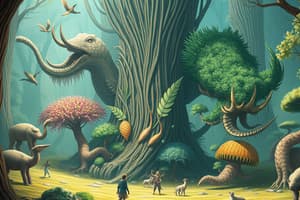Podcast
Questions and Answers
What is the primary distinction between the cell types of Monera and the other kingdoms listed?
What is the primary distinction between the cell types of Monera and the other kingdoms listed?
Monera consists of prokaryotic cells, while Protista, Fungi, Plantae, and Animalia consist of eukaryotic cells.
Which kingdom has a cell wall composed of cellulose and what is its primary mode of nutrition?
Which kingdom has a cell wall composed of cellulose and what is its primary mode of nutrition?
The Plantae kingdom has a cell wall composed of cellulose, and its primary mode of nutrition is photosynthesis.
How does the body organization of Fungi differ from that of Animalia?
How does the body organization of Fungi differ from that of Animalia?
Fungi can be multicellular or form loose tissues, whereas Animalia has a tissue/organ or organ system organization.
Identify the mode of nutrition for organisms in the Animalia kingdom and provide an example.
Identify the mode of nutrition for organisms in the Animalia kingdom and provide an example.
Explain the significance of the presence or absence of a nuclear membrane in the classification of Monera.
Explain the significance of the presence or absence of a nuclear membrane in the classification of Monera.
What distinguishes Mycoplasma from other bacteria?
What distinguishes Mycoplasma from other bacteria?
Why are the boundaries of the kingdom Protista considered not well defined?
Why are the boundaries of the kingdom Protista considered not well defined?
What are the main types of organisms included in the kingdom Protista?
What are the main types of organisms included in the kingdom Protista?
How do diatoms contribute to the ecosystem over time?
How do diatoms contribute to the ecosystem over time?
What reproductive methods do protists use?
What reproductive methods do protists use?
Flashcards are hidden until you start studying
Study Notes
Biological Classification Overview
- Classification systems for living organisms have evolved, maintaining the plant and animal kingdoms while altering understanding of included groups.
- Initially, five kingdoms are recognized: Monera, Protista, Fungi, Plantae, and Animalia, which differ in cell type, structure, organization, and nutrition.
Characteristics of the Five Kingdoms
- Monera: Prokaryotic, non-cellulosic cell wall, lacks nuclear membrane, unicellular body, autotrophic and heterotrophic nutrition.
- Protista: Eukaryotic, cell wall present, with a defined nucleus, unicellular, primarily aquatic, autotrophic and heterotrophic modes of nutrition.
- Fungi: Eukaryotic, cell wall present (chitin), multicellular/loose tissue organization, heterotrophic (saprophytic or parasitic).
- Plantae: Eukaryotic, cellulose-based cell wall, tissue/organ system organization, primarily autotrophic (photosynthesis).
- Animalia: Eukaryotic, no cell wall, tissue/organ system organization, heterotrophic (holozoic nutrition).
Kingdom Protista
- Encompasses all single-celled eukaryotes but is often poorly defined, with examples including Chrysophytes, Dinoflagellates, Euglenoids, Slime moulds, and Protozoans.
- Protists are primarily aquatic and serve as a link to plants, animals, and fungi.
- Reproduction can be both sexual and asexual.
Chrysophytes
- Includes diatoms and golden algae, found in freshwater and marine environments, and are mostly photosynthetic.
- Diatom cell walls are silica-embedded, forming indestructible overlapping shells.
Protozoans
- All protozoans are heterotrophic, existing as predators or parasites.
- Major groups include:
- Amoeboid Protozoans: Move and capture prey with pseudopodia (e.g., Amoeba).
- Flagellated Protozoans: Possess flagella, some being parasitic (e.g., Trypanosoma).
- Ciliated Protozoans: Move via cilia, directing food into their gullet (e.g., Paramoecium).
- Sporozoans: Include organisms with a spore stage, such as Plasmodium (causes malaria).
Kingdom Fungi
- Comprises heterotrophic organisms with diverse morphology and habitat.
- Fungi reproduce mainly through asexual spores (conidia) and can be saprophytes, parasites, or decomposers.
- Common examples include mushrooms and parasitic fungi on plants.
Kingdom Plantae
- Encompasses chlorophyll-containing eukaryotic organisms, including algae, bryophytes, pteridophytes, gymnosperms, and angiosperms.
- Life cycles feature alternation of generations between diploid (sporophyte) and haploid (gametophyte) phases, which can vary in length and independence.
Kingdom Animalia
- Comprises unicellular and multicellular eukaryotic organisms that lack cell walls.
- Nutrition is holozoic, relying on ingestion.
- Early studies identified viruses as pathogens causing specific diseases, noting their classification and structure:
- Viruses are obligate parasites, composed of proteins and either RNA or DNA.
- Regular symptoms of viral infections in plants and animals include various growth and structural abnormalities.
Additional Notes on Viruses and Viroids
- Viruses were first discovered as smaller pathogens affecting tobacco plants, leading to understanding virus structure, including capsid and nucleic acids.
- Viroids, identified in 1971, represent a simpler form of infectious agents.
Studying That Suits You
Use AI to generate personalized quizzes and flashcards to suit your learning preferences.




